Video Lecture
Theory For Making Notes
Lorem ipsum dolor sit amet, consectetur adipiscing elit. Ut elit tellus, luctus nec ullamcorper mattis, pulvinar dapibus leo.
Rigid body rotation about a Moving axis board
Here we analysis the dynamics of rotational motion to some cases in which the axis of rotation a moves. When the happens, the motion of the body is combined translation and rotation. In such situation we always consider that “Every possible motion of a rigid body can be represented as a combination of translational motion of the centre of mass and rotation about an axis through the centre of mass”. This is true even when the centre of mass accelerates, so that it is not at rest in any inertial frame. From example when a bowler throws a ball with spin, in air ball follows a parabolic trajectory as it were a point mass and during this motion the ball is also rotating about its centre of mass. The translation of the centre of mass and the rotation about the centre of mass can eb treated independently.
Energy of a body in simultaneous translation and rotational motion
When a body has both translational rotational motion, its total energy can be written as the sum of the two respective kinetic energies. For example, if a body of mass M is rotating about a given axis with an angular speed ω and its moment of inertia about the axis is I and simultaneously the axis moves with a linear velocity v, its total energy can be written as
\displaystyle K=K{{E}_{{\text{tran}}}}+K{{E}_{{\text{rot}}}}
\displaystyle K=\frac{1}{2}M{{v}^{2}}+\frac{1}{2}I{{\omega }^{2}}
An important case of combined translation and rotation is rolling motion, such as the motion of the wheel shown in figure. The wheel is symmetrical so its centre of mass is at its geometric centre. The rolling motion of this wheel can be analyzed by taking translational and rotational motion separately.
When centre of mass of a wheel moves translationally with a speed vcm along with the body in same direction and when it rotates with an angular speed w about its centre, all points on it revolve in different circular paths with the same angular speed w and the points will have linear tangential speed rw if the point is at a distance r from the axis of rotation. If the angular speed of rotation is such that the linear tangential speed of the points on the periphery of the wheel is equal to the translational speed of wheel, then on combining the two motions, the resultant motion is known as pure rolling motion or rolling motion without slipping. This is shown in figure.
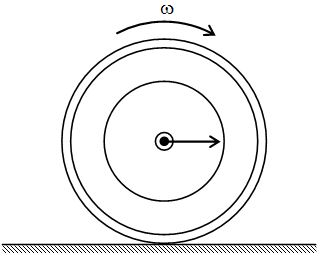
In this situation the point on the wheel that contact the surface must be instantaneously at rest so that it does not slip. Hence the velocity rw of the point of contact relative to the centre of mass must have same magnitude but opposite direction as the centre of mass velocity vcm. Thus for pure rolling.
Vcm = rω
The above relation is the condition of pure rolling. Figure shows the velocity of a point on the wheel is the vector sum of the velocity of the centre of mass and the velocity of the point relative to the centre of mass. Thus while point O, the point of contact, is instantaneously at rest, point 2 at the top of the wheel is moving forward twice as fast as the centre of mass, and point 1 and 3 at the sides have velocities at 45° to the horizontal moving at speed √2 times the centre of mass.

At any instant we can think of the wheel as rotating about an instantaneous axis of rotation that passes through the point of contact with the ground. The angular velocity w is the same for the axis as for an axis through the centre of mass, an observer at the rim watching the centre of mass spin around him. If we think of motion of rolling wheel in this way, the kinetic energy of the wheel is \displaystyle \frac{1}{2}{{I}_{0}}{{\omega }^{2}} where I0 is the moment of inertia of the wheel about an axis through point O. Using parallel axis theorem I0 = Icm + MR2, where Icm is the moment of inertia of the wheel with respect to an axis through the centre of mass. Thus the kinetic energy in this reference is
\displaystyle K=\frac{1}{2}{{I}_{0}}{{\omega }^{2}}=\frac{1}{2}{{I}_{{cm}}}{{\omega }^{2}}+\frac{1}{2}M{{R}^{2}}{{\omega }^{2}}
or = \displaystyle \frac{1}{2}{{I}_{{cm}}}{{\omega }^{2}}+\frac{1}{2}Mv_{{cm}}^{2} \displaystyle \because {{v}_{{cm}}}=R\omega
It is same as that given by equation \displaystyle K=\frac{1}{2}M{{v}^{2}}+\frac{1}{2}I{{\omega }^{2}}. It shows that while solving problems of rolling motion we can solve using both the methods i.e. one by considering the axis of rotation at the centre or in a reference frame attached to the centre of mass of the rolling body and the same problem can also be solved by taking reference frame attached to the instantaneous axis of rotation.
The ratio of rotational kinetic energy and translational kinetic energy
\frac{{\text{Rotational kinetic energy}}}{{\text{Translational kinetic energy}}}=\frac{{\frac{1}{2}I{{\omega }^{2}}}}{{\frac{1}{2}M{{v}^{2}}}} =\frac{{M{{K}^{2}}{{\omega }^{2}}}}{{M{{R}^{2}}{{\omega }^{2}}}}=\frac{{{{K}^{2}}}}{{{{R}^{2}}}}
The ratio of rotation kinetic energy and total energy
\frac{{\text{Rotational kinetic energy}}}{{\text{Total energy}}}=\frac{{\frac{1}{2}I{{\omega }^{2}}}}{{\frac{1}{2}M{{v}^{2}}+\frac{1}{2}I{{\omega }^{2}}}} =\frac{{M{{K}^{2}}{{\omega }^{2}}}}{{M{{R}^{2}}{{\omega }^{2}}+M{{K}^{2}}{{\omega }^{2}}}}= {\frac{{{{K}^{2}}}}{{{{R}^{2}}+{{K}^{2}}}}}
The ratio of translational kinetic energy and total energy
\frac{{\text{Translational kinetic energy}}}{{\text{Total energy}}}=\frac{{\frac{1}{2}M{{v}^{2}}}}{{\frac{1}{2}M{{v}^{2}}+\frac{1}{2}I{{\omega }^{2}}}} =\frac{{M{{v}^{2}}}}{{M{{v}^{2}}+M{{K}^{2}}\frac{{{{v}^{2}}}}{{{{R}^{2}}}}}}=\frac{1}{{1+\frac{{{{K}^{2}}}}{{{{R}^{2}}}}}}={\frac{{{{R}^{2}}}}{{{{R}^{2}}+{{K}^{2}}}}}
When the pure rolling takes place on a rough surface the static friction acts between the body and the surface. where as in case of rolling with slipping the kinetic friction acts.
Rolling | Rolling with Slipping | ||
(i) | Value of friction force (f) | 0 ≤fstatic≤fmax | fkinetic = fmax |
(ii) | W.D. by friction force(f) | Wf = 0 | Wf ≠ 0 |
Acceleration and the frictional force acting on a rigid body of radius of gyration k and radius R rolls (without slipping) down a plane inclined at an angle with horizontal :
When the body is placed on the inclined plane, it tries to slip down and hence a static friction f acts upwards. This friction provides a torque which causes the body to rotate. Let a be the linear acceleration of centre of mass and be the angular acceleration of the body.
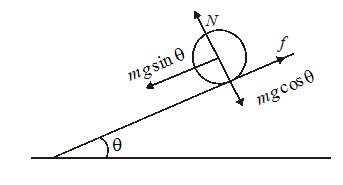
From free body diagram :
for linear motion parallel to the plane apply Fnet = m.a
\displaystyle mg\sin \theta -f=ma———-(i)
for rotation around the axis through centre of mass apply \displaystyle \tau =I\alpha
\displaystyle \Rightarrow fR={{I}_{{cm}}}\alpha —–(ii) here Icm is moment of inertia about the center of mass and can be written as mk2.
wherek is radius of gyration
note that mg is acting at the center therefore its torque about the center is zero
As there is no slipping, the point of contact of the body with plane is instantaneously at rest.
hence \displaystyle v=R\omega
and \displaystyle a=R\alpha ———(iii)
Solving the three equations for a and f :
we get
\displaystyle a=\frac{{g\sin \theta }}{{1+\frac{{{{I}_{{cm}}}^{2}}}{{m{{R}^{2}}}}}} Or \displaystyle a=\frac{{g\sin \theta }}{{1+\frac{{{{k}^{2}}}}{{{{R}^{2}}}}}} and \displaystyle f=\frac{{mg\sin \theta }}{{1+\frac{{{{R}^{2}}}}{{{{k}^{2}}}}}}
Condition for pure rolling (rolling without slipping)
To avoid slipping, the friction must be static in nature, whose maximum value is
\displaystyle f\le {{\mu }_{s}}N
\displaystyle \frac{{g\sin \theta }}{{1+{{R}^{2}}/{{K}^{2}}}}\le {{\mu }_{s}}mg\cos \theta
\displaystyle {{\mu }_{s}}\ge \frac{{\tan \theta }}{{1+\frac{{{{R}^{2}}}}{{{{k}^{2}}}}}}
Time taken by the rolling body to reach the bottom of the inclined plane
Using S=ut+\frac{1}{2}a{{t}^{2}}, we get
l=\frac{1}{2}a{{t}^{2}}or t=\sqrt{{\frac{{2l}}{a}}}or t=\sqrt{{\frac{{2l\left[ {1+\frac{{{{K}^{2}}}}{{{{R}^{2}}}}} \right]}}{{g\sin \theta }}}}
This is the condition of μsfor rolling without slipping.
Important Points To Remember
1.
For solid sphere, \displaystyle {{I}_{{cm}}}=\frac{2}{5}m{{R}^{2}}, \displaystyle a=\frac{5}{7}g\sin \theta
2.
For hollow sphere, \displaystyle {{I}_{{cm}}}=\frac{2}{3}m{{R}^{2}}, \displaystyle a=\frac{3}{5}g\sin \theta
3.
For disc or solid cylinder, \displaystyle {{I}_{{cm}}}=\frac{1}{2}m{{R}^{2}}, \displaystyle a=\frac{2}{3}g\sin \theta
4.
For ring or hollow cylinder, \displaystyle {{I}_{{cm}}}=m{{R}^{2}}, \displaystyle a=\frac{1}{2}g\sin \theta
Note: We can see that acceleration is independent of mass and radius of the body but it depends on the geometrical shape of the body and inclination of plane.
5.
Body | k | ETranslation | ERotation | ETotal | Ratio of ETranslation& ETotal | Ratio of ERotation& ETotal |
Ring or Hollow Cylinder | R | \displaystyle \frac{1}{2}Mv2 | \displaystyle \frac{1}{2}Mv2 | Mv2 | \displaystyle \frac{1}{2} | \displaystyle \frac{1}{2} |
Disc or Solid Cylinder | \displaystyle \frac{R}{{\sqrt{2}}} | \displaystyle \frac{1}{2}Mv2 | \displaystyle \frac{1}{4}Mv2 | \displaystyle \frac{3}{4}Mv2 | \displaystyle \frac{2}{3} | \displaystyle \frac{1}{3} |
Solid Sphere | \displaystyle \sqrt{{\frac{2}{5}}}R | \displaystyle \frac{1}{2}Mv2 | \displaystyle \frac{1}{5}Mv2 | \displaystyle \frac{7}{10}Mv2 | \displaystyle \frac{5}{7} | \displaystyle \frac{2}{7} |
Spherical Shell | \displaystyle \sqrt{{\frac{2}{3}}}R | \displaystyle \frac{1}{2}Mv2 | \displaystyle \frac{1}{3}Mv2 | \displaystyle \frac{5}{6}Mv2 | \displaystyle \frac{3}{5} | \displaystyle \frac{2}{5} |
Illustration
A circular disc rolls down an inclined plane with a height ‘h’ from horizontal surface. Find
(a) Direction of friction force on disc
(b) What will be the fraction of the total energy associated with its translational energy?
(c) Is there any work done by friction force (yes/no)?
Answers
(a) Upward along inclined surface.
(b) \displaystyle \frac{{{{E}_{{Translational}}}}}{{{{E}_{{Total}}}}}=\frac{{\frac{1}{2}m{{v}^{2}}}}{{\frac{1}{2}m{{v}^{2}}+\frac{1}{2}I{{\omega }^{2}}}}=\frac{2}{3}.
(c) In case of rolling, there is no slipping so work done by the friction force is zero.
Illustration
A sphere of radius r and mass m is released from rest from the top of an inclined plane from a height h. Find its velocity at the bottom of the plane. If (a) plane is smooth, (b) plane is sufficiently rough
(a) In the case of switch plane the sphere slides down without rolling and hence applying conservation of energy we get
\displaystyle mgh\,\,=\,\,\frac{1}{2}\,\,m{{v}^{2}}\,\,\Rightarrow \,\,\,\,\,v\,\,=\,\,\sqrt{{2gh}}
(b) In case of rough plane the sphere rolls down hence applying conservation of energy we get
\displaystyle mgh\,\,=\,\,\frac{1}{2}\,\,m{{v}^{2}}\,\,\,+\,\,\frac{1}{2}\,\,I{{\omega }^{2}}\,\,\,\,\,\,\,\,\,\,[Where\,\,I\,\,=\,\,\frac{2}{5}\,\,m{{r}^{2}}]
\displaystyle \Rightarrow \,\,\,\,\,mgh\,\,=\,\frac{1}{2}\,\,m{{v}^{2}}\,\,+\,\,\frac{1}{2}\,\,\,\,\left[ {\frac{2}{5}\,\,m{{r}^{2}}} \right]\,\,\,\,{{\left[ {\frac{v}{r}} \right]}^{2}}
\displaystyle \Rightarrow \,\,\,\,\,mgh\,\,=\,\frac{1}{2}\,\,m{{v}^{2}}\,\,+\,\,\frac{1}{5}\,\,m{{v}^{2}}
Hence \displaystyle v\,\,=\,\,\sqrt{{\frac{{10}}{7}\,\,gh}}
Illustration
A spherical ball is given a translation velocity equal to v0 and pushed along a horizontal surface where the coefficient of friction is μ. Calculate when it begins to roll without slipping.

(i) Velocity of centre of mass
(ii) The time taken.
Solution
The point of contact has a forward velocity when the ball starts moving. This causes slipping and hence a kinetic friction equal to µmg acts in backward direction. This frictional force provides a clock-wise torque and hence the angular velocity increases from zero to ω in time t. The same frictional force reduces the linear velocity of centre of mass from v0 to v in time t.
If the ball begins to roll without slipping after time t,
v = rω
Using v = u + at for linear motion of centre of mass,
v = v0 – \displaystyle \left( {\frac{{\mu mg}}{m}} \right)\ t
v = v0 – μ gt … (i)
Using ωf = ωi + at andt = Ia for rotation:
w = 0 + \displaystyle \left( {\frac{{\mu mgr}}{I}} \right)\ t … (ii)
We also have v = rω for pure rolling (iii)
t = \displaystyle \left( {\frac{{{{v}_{0}}{{k}^{2}}}}{{{{k}^{2}}+{{r}^{2}}}}} \right)\ \frac{1}{{\mu g}} (where I = mk2)
and v = \displaystyle \frac{{{{v}_{0}}{{r}^{2}}}}{{{{k}^{2}}+{{r}^{2}}}}
For a solid sphere k2 = 2/5 r2
time (t) = \displaystyle \frac{{2{{v}_{0}}}}{{7\mu g}} and v = 5/7 v0
Hence after \displaystyle \frac{{2{{v}_{0}}}}{{7\mu g}} seconds, the translational speed of ball reduces to 5/7 v0 and it begins to roll without slipping.
Illustration
A solid cylinder of mass M and radius R rolls down an inclined plane with height h without slipping. Find the speed of its centre of mass when it reaches its bottom.
Solution
From COE, mgh = \displaystyle \frac{1}{2}mv2 + \displaystyle \frac{1}{2}Iω2
mgh = \displaystyle \frac{1}{2}mv2 + \displaystyle \frac{1}{2}. ( \displaystyle \frac{1}{2}mR2) ´ \displaystyle \frac{{{{v}^{2}}}}{{{{R}^{2}}}} = \displaystyle \frac{3}{4}mv2
v = \displaystyle \sqrt{{\frac{{4gh}}{3}}}
Illustration
A solid cylinder of radius 4 cm and mass 250 g rolls down an inclined plane (1 in 10). Find the acceleration and the total energy of the cylinder after 5 sec.
Solution: Given that:R=4cm= 0.04m, M=250g = 0.25kg
\sin \alpha =\frac{1}{{10}},
The acceleration of a body rolling down an inclined plane is given by a=\frac{{g\sin \alpha }}{{1+\frac{{{{K}^{2}}}}{{{{r}^{2}}}}}}.
But the M.I. of the solid cylinder about its own axis =I=\frac{1}{2}M{{R}^{2}}=M{{K}^{2}}
Where K = radius of gyration
K=\frac{{{{K}^{2}}}}{{{{R}^{2}}}}=\frac{1}{2}
a=\frac{{g\sin \alpha }}{{1+\frac{1}{2}}} =\frac{2}{3}g\sin \alpha =\frac{2}{3}\times 9.8\times \frac{1}{{10}}\text{m/}{{\text{s}}^{2}}=0.653\ \text{m/}{{\text{s}}^{2}}
Now by 1st equation of motion
v=u+at=0+0.653\times 5\ \text{m/s}=\text{3}\text{.26}\,\text{m/s}
As the cylinder is rolling, the total K.E. of the cylinder is the sum of both K.E. of translation and rotation.
Total K.E. =\frac{1}{2}M{{v}^{2}}+\frac{1}{2}I{{\omega }^{2}} =\frac{1}{2}M{{v}^{2}}+\frac{1}{2}\frac{1}{2}M{{R}^{2}}.\frac{{{{v}^{2}}}}{{{{R}^{2}}}} \left( {\because \ \ \ \ \omega =\frac{v}{R}} \right)
=\frac{3}{4}M{{v}^{2}}=\frac{3}{4}\times 0.25\times {{(3.26)}^{2}}\text{J}=\text{2}\text{.0J}
Illustration
A ring, a disc and a sphere all of the same radius and mass roll down an inclined plane the same height h. Which of the three reaches the bottom (i) earliest, (ii) lastest?
Solution: The acceleration of a body rolling down an inclined plane is given by,
a=g\sin \alpha \left( {\frac{{M{{R}^{2}}}}{{I+M{{R}^{2}}}}} \right)
For a ring, I=M{{R}^{2}}
a=g\sin \alpha \left( {\frac{{M{{R}^{2}}}}{{M{{R}^{2}}+M{{R}^{2}}}}} \right)=\frac{1}{2}g\sin \alpha =0.5g\sin \alpha
For a disc, I=\frac{1}{2}M{{R}^{2}}
a=g\sin \alpha \left( {\frac{{M{{R}^{2}}}}{{\frac{1}{2}M{{R}^{2}}+M{{R}^{2}}}}} \right)=\frac{2}{3}g\sin \alpha =0.67g\sin \alpha
For a sphere, I=\frac{2}{5}M{{R}^{2}}
a=g\sin \alpha \left( {\frac{{M{{R}^{2}}}}{{\frac{2}{5}M{{R}^{2}}+M{{R}^{2}}}}} \right)=\frac{5}{7}g\sin \alpha =0.71\ g\sin \alpha .
Illustration
A 10 m long ladder rests against a vertical wall and makes an angle of 60o with the horizontal floor. If it starts to slip, then find the position of its instantaneous axis of rotation.
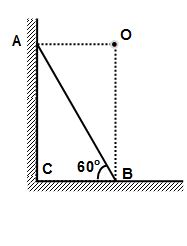
Solution
Consider the ends A and B of the ladder. Velocity of end A is vertically downward and velocity of end B is along the horizontal floor. As perpendiculars to the velocities meet at point O. Therefore, axis of rotation will pass through this point and will be perpendicular to the plane of ABC.
Taking C as origin co-ordinates of the point O are 10 cos60°m and 10sin60°m. Hence radius vector of the point O w.r.t. point C is \displaystyle \vec{R}=5\hat{i}+5\sqrt{3}\hat{j} where \displaystyle \hat{i} and \displaystyle \hat{j} are the unit vectors along horizontal and vertical.
Illustration
A sphere of mass m and radius r is released from rest at point A on a track in vertical plane. From A to B track is rough enough to support rolling and form B onwards it is smooth. Find the maximum height attained by sphere from ground on its journey B onwards.
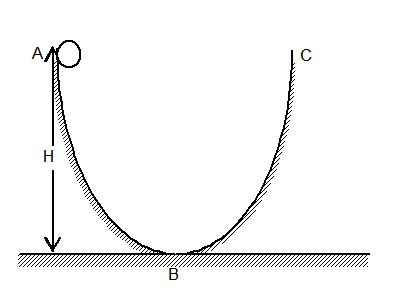
Solution
From COE
mgH = \displaystyle \frac{1}{2}mv_{c}^{2}+\frac{1}{2}.\frac{2}{5}m{{r}^{2}}\frac{{v_{c}^{2}}}{{{{r}^{2}}}}ÞmgH = \displaystyle \frac{7}{{10}}m
From B onward
\displaystyle \frac{1}{2}{{I}_{c}}{{\omega }^{2}}+mgh=\frac{1}{2}{{I}_{c}}{{\omega }^{2}}+\frac{1}{2}mv_{c}^{2}
h = \displaystyle \frac{{v_{c}^{2}}}{{2g}}=\frac{{10}}{{14}}H = \displaystyle \frac{{5H}}{7}
Illustration
A man pushes a cylinder of mass 2m with the help of a plank of mass m as shown in figure. There is no slipping at any contact. The horizontal component of the force applied by the man is F. Find the acceleration of plank and the acceleration of cylinder. The magnitude of force is 2mg.
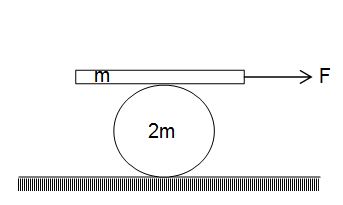
Solution
Frictional forces are shown in diagram
F – f1 = maP …(1)
f1 + f2 = 2maC …(2)
(f1 – f2) r = \displaystyle \frac{{m{{r}^{2}}}}{2}\times \alpha …(3)
since there is no slipping
aC = ra …(4)
and aP = 2aC …(5)
by solving the above equations and putting F = 2mg
we get aC = \displaystyle \frac{8}{{13}}g = \displaystyle \frac{{80}}{{13}} m/sec2
aP = \displaystyle \frac{{16}}{{13}}g = \displaystyle \frac{{160}}{{13}}m/sec2
Illustration
A uniform solid cylinder of radius R = 15cm rolls over a horizontal plane passing into an inclined plane forming an angle a = 30° with the horizontal. Find the maximum value of the velocity v0 which still permits the cylinder to roll onto the inclined plane section without a jump. (The sliding is assumed to be absent).

Solution
Initial energy
\displaystyle {{E}_{1}}=\frac{1}{2}mv_{0}^{2}+\frac{1}{2}{{I}_{{c.m.}}}{{\omega }^{2}}+mgR
For rolling, \displaystyle \frac{{{{v}_{0}}}}{R}=\omega
\displaystyle {{E}_{1}}=\frac{1}{2}mv_{0}^{2}+\frac{1}{2}.\frac{1}{2}m{{R}^{2}}\frac{{v_{0}^{2}}}{{{{R}^{2}}}}+mgR=\frac{3}{4}mv_{0}^{2}+mgR
As it reaches the edge
\displaystyle {{E}_{2}}=\frac{1}{2}{{I}_{P}}{{\omega }^{2}}+mgR\cos \alpha
\displaystyle {{E}_{2}}=\frac{1}{2}m{{v}^{2}}+\frac{1}{2}{{I}_{{c.m.}}}{{{\omega }’}^{2}}+mgR\cos \alpha =\frac{3}{4}m{{v}^{2}}+mgR\cos \alpha
From COE, \displaystyle \frac{3}{4}m{{v}^{2}}+mgR\cos \alpha =\frac{3}{4}mv_{0}^{2}+mgR
\displaystyle m{{v}^{2}}=mv_{0}^{2}+\frac{4}{3}mgR(1-\cos \alpha ) … (1)
Consider the F.B.D. of the cylinder when it is at edge. Centre of mass of the cylinder describes circular motion about P.
Hence, mg cosa – N = mv2 / R
N = mg cosa – mv2 / R
= \displaystyle mg\cos \alpha -\frac{{mv_{0}^{2}}}{R}-\frac{4}{3}mg+\frac{4}{3}mg\cos \alpha , from (1)
For no jumping, N ³ 0
\displaystyle \frac{7}{3}mg\cos \alpha -\frac{4}{3}mg-\frac{{mv_{0}^{2}}}{R}\ge 0
\displaystyle {{v}_{0}}\le \sqrt{{\frac{{7gR}}{3}\cos \alpha -\frac{4}{3}gR}}.
Illustration
A bobbin is pushed along on a rough stationary horizontal surface as shown in the figure. The board is kept horizontal and there is no slipping at any contact points. Find the distance moved by the board when distance moved by the axis of the bobbin is l.
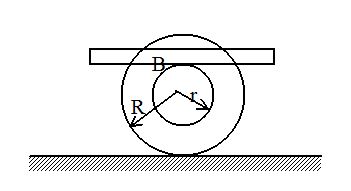
Solution
For no slipping vcm = wR … (i)
vB = wr + vcm = vcm \displaystyle \left( {1+\frac{r}{R}} \right) … (ii)
\displaystyle \frac{{{{I}_{{cm}}}}}{I}=\frac{{{{v}_{{cm}}}}}{v}=\left( {1+\frac{r}{R}} \right) IB = Icm. \displaystyle \left( {1+\frac{r}{R}} \right)
Illustration
A small sphere of radius r is released from point ‘A’ inside the fixed large hemispherical bowl of radius R as shown in figure. If the friction between the sphere and the bowl is sufficient enough to prevent any slipping then find
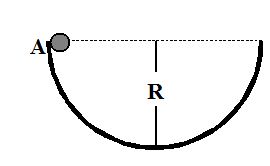

(a) what fractions of the total energy are translational and rotational , when the small sphere reaches the bottom of the hemisphere.
(b) and also the normal force exerted by the small sphere on the hemisphere when it is at the bottom of the hemisphere.
Solution
Ktrans = \displaystyle \frac{1}{2}m{{v}^{2}}
Krot = \displaystyle \frac{1}{2}I{{\omega }^{2}}=\frac{1}{5}m{{v}^{2}}
K = Ktrans + Krot = \displaystyle \frac{7}{{10}}m{{v}^{2}}
\displaystyle \frac{{{{K}_{{trans}}}}}{K}=\frac{5}{7}
\displaystyle \frac{{{{K}_{{rot}}}}}{K}=\frac{2}{7}
mg(R – r) = \displaystyle \frac{7}{{10}}mv2
\displaystyle \left( {\frac{{m{{v}^{2}}}}{{R-r}}} \right)=\frac{{10}}{7}mg
N = mg + \displaystyle \left( {\frac{{m{{v}^{2}}}}{{\left( {R-r} \right)}}} \right)=\frac{{17}}{7}mg
Illustration
A rotating ball hits a rough horizontal plane with a vertical velocity v and angular velocity w. Given that the co-efficient of friction is m and the vertical velocity of the ball after the collision is v/2, find the angular velocity after collision.
Solution
\displaystyle v_{1}^{2}=2gh
v1 = \displaystyle \sqrt{{2gh}} = v(say)
\displaystyle v_{2}^{2}=\sqrt{{2gh/2}}
v2 = \displaystyle \sqrt{{gh}} = v/√2
\displaystyle \int{{Ndt}}=m\left( {\frac{v}{{\sqrt{2}}}+v} \right) . . . (i)
Where N = impact force on the ball during collision.
\displaystyle \int{{fRdt}}= Ic.m.(-w’ + w)
\displaystyle \int{{\mu NRdt}}=Ic.m.(w – w’) . . . (ii)
From (i) and (ii), we get
mR. \displaystyle \frac{1}{{\sqrt{2}}}mv (1 + \sqrt{2}) = \frac{2}{5}mR2(w -w’)
w’ = w – \displaystyle \frac{{5\mu }}{{2R}}(1+\sqrt{2})\sqrt{{gh}}.
Illustration
You are given two spheres of the same mass and size and appearance, but one of them is hollow and the other is solid. How will you find which is hollow and which is solid.
Solution:
If K1 and K2 be the radii of gyration of the solid and hollow spheres respectively. Then
M.I. of solid sphere =\frac{2}{5}M{{R}^{2}}=MK_{1}^{2}
or K_{1}^{2}=\frac{2}{5}{{R}^{2}} and M.I. of hollow sphere =\frac{2}{5}M\frac{{{{R}^{5}}-{{r}^{5}}}}{{{{R}^{3}}-{{r}^{3}}}}=MK_{2}^{2}
or K_{2}^{2}=\frac{2}{5}\frac{{{{R}^{5}}-{{r}^{5}}}}{{{{R}^{3}}-{{r}^{3}}}}=\frac{2}{5}{{R}^{2}}\frac{{\left( {1-\frac{{{{r}^{5}}}}{{{{R}^{5}}}}} \right)}}{{\left( {1-\frac{{{{r}^{3}}}}{{{{R}^{3}}}}} \right)}}
where r and R are the inner and outer radii of the hollow sphere. Clearly r<R.
\frac{{{{r}^{5}}}}{{{{R}^{5}}}}<\frac{{{{r}^{3}}}}{{{{R}^{3}}}}
or \displaystyle 1-\frac{{{{r}^{5}}}}{{{{R}^{5}}}}>1-\frac{{{{r}^{3}}}}{{{{R}^{3}}}}
or, \frac{{\left( {1-\frac{{{{r}^{5}}}}{{{{R}^{5}}}}} \right)}}{{\left( {1-\frac{{{{r}^{3}}}}{{{{R}^{3}}}}} \right)}}>1
or \frac{2}{5}{{R}^{2}}\frac{{\left( {1-\frac{{{{r}^{5}}}}{{{{R}^{5}}}}} \right)}}{{\left( {1-\frac{{{{r}^{3}}}}{{{{R}^{3}}}}} \right)}}>\frac{2}{5}{{R}^{2}}
or, K_{2}^{2}>k_{1}^{2} (using above relations)
or {{K}_{2}}>{{K}_{1}}
i.e., the radius of gyration of the hollow sphere is greater than that of solid sphere. The acceleration of a body rolling down an inclined plane is given by, a=\frac{{g\sin \alpha }}{{1+\frac{{{{K}^{2}}}}{{{{r}^{2}}}}}}
Clearly if K is greater, the acceleration will be smaller. Hence the acceleration of the hollow sphere should be lesser than that of the solid sphere if allowed to roll at the same time i.e., the solid sphere will sooner come down the plane and hence both can be distinguished.
Illustration
The acceleration :a” of the supporting surface (see figure) required to keep the centre G of the circular cylinder in a fixed position during the motion if there is no slipping between the cylinder and the support will be
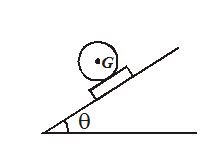
(1) g\sin \theta
(2) \frac{{(g\sin \theta )}}{2}
(3) \displaystyle 2g\sin \theta
(4) 4g\sin \theta
Solution:
Net force on the cylinder acting parallel to the inclined plane.
For the motion of cylinder, ma\prime =mg\sin \theta -{{f}_{r}}
The centre of mass of cylinder is stationary. a\prime =\frac{{{{d}^{2}}x}}{{d{{t}^{2}}}}=0
{{f}_{r}}=mg\sin \theta
Torque due to frictional force ={{f}_{r}}R=\frac{{m{{R}^{2}}}}{2}\alpha
{{f}_{r}}=\frac{{mR\alpha }}{2}=\frac{{ma}}{2}
\frac{{ma}}{2}=mg\sin \theta
a=2g\sin \theta
Option (3) Is The Correct Answer.
Practice Questions (Basic Level)
1.
A wheel is in pure rolling condition on a level road. If velocity of centre of mass is then velocity of topmost point is
(a) \overrightarrow{{v\,}}
(b) 2\overrightarrow{{v\,}}
(c) zero
(d) \sqrt{{2\overrightarrow{v}}}
Ans (b)
2.
A sphere rolls down an inclined plane. What fraction of its energy is rotational?
(a) \frac{2}{7}
(b) \frac{3}{7}
(c) \frac{4}{7}
(d) \frac{5}{7}
Ans (a)
3.
A circular disc is rolling down on inclined plane without slipping. If the angle of inclination is 30°, the acceleration of the disc down the inclined plane is
(a) g
(b) \frac{g}{2}
(c) \frac{g}{3}
(d) \frac{{\sqrt{2}}}{3}g
Ans (c)
4.
A body is in pure rolling on horizontal ground and its goes from rough region AB to perfectly smooth region BC. Then in region BC

(a) body will stop rolling after some time
(b) body will stop rotating after some time
(c) body will continue rolling
(d) body will start rolling with forward slipping
Ans (c)
5.
The speed of a homogeneous solid sphere after rolling down an inclined plane of vertical height h, from rest without sliding is:
(a) \sqrt{{gh}}
(b) \sqrt{{\left( {\frac{1}{5}} \right)}}gh
(c) \sqrt{{\left( {\frac{4}{3}} \right)}}gh
(d) \sqrt{{\left( {\frac{{10}}{7}} \right)}}gh
Ans (d)
6.
Work done by friction in case of pure rolling:
(a) is always zero
(b) is always positive
(c) is always negative
(d) may be positive and negative
Ans (b)
7.
A Sphere is rolling down a plane of inclination q to the horizontal. The acceleration of its centre, down the plane is:
(a) g sin q
(b) less than g sin q
(c) greater than g sin q
(d) greater than \frac{{g\,\sin \,\theta }}{2}
Ans (b)
8.
A sphere of mass M rolls without slipping on an inclined plane of inclination q. What should be the minimum coefficient of friction, so that the sphere rolls down without slipping?
(a) \frac{2}{5}\tan \theta
(b) \frac{2}{7}\tan \theta
(c) \frac{5}{7}\tan \theta
(d) \tan \theta
Ans (b)
9.
A cylinder of mass 10 kg and radius 15 cm is rolling perfectly on a plane of inclination 30o. The coefficient of static friction is µs = 0.25.
(a)
How much is the force of friction acting on the cylinder?
(a)12.4 N
(b) 15.3 N
(c)16.4 N
(d) 16.0 N
Ans(c)
(b)
What is the work done against friction during rolling?
(a)0
(b)1
(c)5
(d)9
Ans(a)
(c)
Used, at what value of q does the cylinder begin to skid and not roll perfectly?
(a)40o
(b)30o
(c)25o
(d)37o
Ans(d)
Comprehension Based Question (10 to 12)
Consider a uniform disc of mass m, radius r, rolling without slipping on a rough surface with linear acceleration a and angular acceleration due to an external force F as shown in the figure. Coefficient of friction is µ.

10.
The work done by the frictional force at the instant of pure rolling is
(a) \frac{{\mu mga{{t}^{2}}}}{2}
(b) \mu mga{{t}^{2}}
(c) \mu mg\frac{{a{{t}^{2}}}}{\alpha }
(d) zero
Ans (d)
11.
The magnitude of frictional force acting on the disc is
(a) ma
(b) mmg
(c) \frac{{ma}}{2}
(d) zero
Ans (c)
12.
Angular momentum of the disc will conserved about
(a) center of mass
(b) point of contact
(c) at point at a distance 3R/2 vertical above the point of contact
(d) about a point at a distance 4R/3 vertically above the point of contact
Ans (c)
13.
A disc of mass M and radius R is rolling with angular speed w on a horizontal plane as shown in figure. The magnitude of angular momentum of the disc about O is

(a) \displaystyle \frac{{M{{R}^{2}}}}{2}\omega
(b) \displaystyle M{{R}^{2}}\omega
(c) \displaystyle \frac{3}{2}M{{R}^{2}}\omega
(d) \displaystyle 2M{{R}^{2}}\omega
Ans (c)
Practice Questions (JEE Main Level)
1.
Find the least coefficient of friction between surfaces of inclined plane (inclination angle = a) and solid cylinder such that cylinder will roll down without slipping
(a) \frac{2}{3}\tan \alpha
(b) \frac{2}{7}\tan \alpha
(c) \frac{1}{3}\tan \alpha
(d) \frac{5}{7}\tan \alpha
Ans (c)
2.
A constant horizontal force F is applied on the top of a solid sphere and a hollow sphere of same mass and radius both kept on a sufficiently rough surface. Let a1 and a2 be their liner accelerations then:

(a) a1 = a2
(b) a1>a2
(c) a1<a2
(d) data insufficient
Ans (b)
3.
A force F acts tangentially at the highest point of the sphere of mass M kept on a rough horizontal plane. If the sphere rolls without slipping, the acceleration of the centre of sphere is:
(a) \frac{{10F}}{{7M}}
(b) \frac{{10F}}{{7M}}
(c) \frac{{10M}}{{7F}}
(d) \frac{{10}}{7}MF
Ans (a)
4.
A ring is kept on a rough surface. But the coefficient of friction is less than the minimum value required for pure rolling. At any instant of time let KT and KR be the translational and rotational kinetic energies of the ring, then
(a) KR = KT
(b) KR> KT
(c) KT> KR
(d) KR = 0
Ans (c)
Comprehension Based Question (5 to 7)
A solid sphere is projected on a rough horizontal ground with initial velocity v and angular velocity w as shown in figure. It is seen that the angular velocity and velocity of center of mass become zero simultaneously after the sphere move a distance d.

5.
What is the angular momentum of sphere about O?
(a) -\frac{3}{5}m{{r}^{2}}\omega
(b) \frac{3}{5}m{{r}^{2}}\omega
(c) \frac{8}{5}m{{r}^{2}}\omega
(d) zero
Ans (d)
6.
What is relation between v and w?
(a) v=\frac{2}{5}r\omega
(b) v=\frac{{r\omega }}{5}
(c) v=\frac{3}{5}\omega r
(d) v=\frac{{r\omega }}{2}
Ans (a)
7.
What is the work done by friction during motion.
(a) µmgd
(b) \frac{2}{5}\mu mgd
(c) \frac{8}{5}\mu mgd
(d) \frac{7}{2}\mu mgd
Ans (d)
8.
A disc of radius R rolls on a horizontal ground with linear acceleration a and angular acceleration a as shown in figure. The magnitude of acceleration of point P at an instant, when its linear velocity is V and angular velocity is w, will be

(a) \displaystyle \sqrt{{{{{(a+ra)}}^{2}}+{{{(r{{w}^{2}})}}^{2}}}}
(b) \displaystyle \frac{{ar}}{R}
(c) \displaystyle \sqrt{{{{r}^{2}}{{a}^{2}}+{{r}^{2}}{{w}^{4}}}}
(d) \displaystyle ra
Ans (a)
9.
A solid sphere and a disc of the same mass and radius roll up an incline. Find the ratio of the heights, hs/hd, (Where hsandhd are heights attained by the sphere and the disc respectively) to which they rise if, at the bottom, they have the same
(a)
kinetic energy
(a) 0
(b) 1
(c)3
(d) 5
Ans (b)
(b)
speed
(a)12/17
(b)12/11
(c)14/15
(d)20/7
Ans (c)
10.
The free end of the string wound on the surface of a solid cylinder of mass M and radius R is pulled by a force F applied vertically as shown. If the cylinder rolls on the horizontal surface without slipping, find the maximum angular acceleration that the cylinder can have without losing contact with the surface.

(a) \frac{{2g}}{{5R}}
(b) \frac{{2g}}{{3R}}
(c) \frac{{3g}}{{2R}}
(d) \frac{{5g}}{{3R}}
Ans (b)
11.
A solid sphere of radius R is given a linear velocity voand an angular velocity \frac{{4{{v}_{o}}}}{R} as shown and released on a horizontal rough surface where coefficient of friction is m.

(a)
Find time after which pure rolling starts.
(a) \frac{{5{{v}_{o}}}}{{3\mu g}}
(b) \frac{{10{{v}_{o}}}}{{3\mu g}}
(c) \frac{{3{{v}_{o}}}}{{7\mu g}}
(d) \frac{{10{{v}_{o}}}}{{7\mu g}}
Ans (d)
(b)
How much distance the sphere travels before the start of pure rolling?
(a) \frac{{38v_{o}^{2}}}{{28\mu g}}
(b) \frac{{22v_{o}^{2}}}{{30\mu g}}
(c) \frac{{58v_{o}^{2}}}{{98\mu g}}
(d) \frac{{v_{o}^{2}}}{{\mu g}}
Ans (c)
(c)
What is the position of the sphere from the initial position at which pure rolling starts?
(a) \frac{{40v_{o}^{2}}}{{98\mu g}} [towards right]
(b) \frac{{22v_{o}^{3}}}{{98\mu g}} [towards right]
(c) \frac{{3v_{o}^{-2}}}{{23\mu g}} [towards right]
(d) \frac{{v_{o}^{2}}}{{\mu g}} [towards right]
Ans (a)
(d)
What is the linear velocity of the body at the time of pure rolling?
(a) \frac{2}{5}{{v}_{o}}
(b) \frac{-7}{3}{{v}_{o}}
(c) \frac{-3}{7}{{v}_{o}}
(d) \frac{3}{7}{{v}_{o}}
Ans (d)
(e)
Whether the sphere comes back to its initial position? And if so, after how much time?
(a) yes, after \frac{{30{{v}_{o}}}}{{2\mu g}}
(b) yes, after \frac{{50{{v}_{o}}}}{{21\mu g}}
(c) yes, after \frac{{60{{v}_{o}}}}{{37\mu g}}
(d) yes, after \frac{{48{{v}_{o}}}}{{30\mu g}}
Ans (b)
Practice Questions (JEE Advance Level)
1.
A uniform cylinder of mass M and radius R rolls without slipping down a slope of angle q to the horizontal. The cylinder is connected to a spring constant k while the other end of the spring is connected to a rigid support at P. The cylinder is released when the spring is unstretched. The maximum distance that the cylinder travels is:

(a) \frac{3}{4}\,\,\frac{{Mg\,\sin \,\theta }}{k}
(b) \frac{{Mg\,\tan \,\theta }}{k}
(c) \frac{{2Mg\,\sin \,\theta }}{k}
(d) \frac{4}{3}\,\,\frac{{Mg\,\sin \,\theta }}{k}
Ans (c)
Comprehension Based Question (2 to 4)
When a sphere rolls on a rough horizontal surface under the action of a constant horizontal force F acting on the center of the sphere; it acquires acceleration a (of center of mass) and angular acceleration a (about center of mass). These value can be obtained by applying Newton’s second law in both translational and rotational form. The free body diagram of the sphere will look like:

Here f is the force of friction and R be the radius of sphere.
∑F = ma = F – f = ma
= ∑t = Ia Þ f. R = I a
and a = aR (condition of rolling)
After solving these three equations we get,
a=\frac{F}{{m\left( {1+\frac{I}{{m{{R}^{2}}}}} \right)}}
f=\frac{F}{{1+\frac{{m{{R}^{2}}}}{I}}}
Now since the nature of friction is static in case of rolling motion; coefficient of friction between ground and sphere should be able to provide the required value of static friction.
i.e. \mu N\ge \frac{F}{{1+\frac{{m{{R}^{2}}}}{I}}}
If the above criterion is satisfied the sphere will do rolling motion and the work done by friction force will be zero since point of contact is instantaneously at rest.
Now consider a situation when \mu N\not{\ge }\frac{F}{{1+\frac{{m{{R}^{2}}}}{I}}}. Then coefficient of friction is not sufficient to provide the necessary value of static friction and so the friction force will essentially be kinetic in nature. It implies that point of contact will have relative motion with respect to ground i.e. it will slip.

In the case of slipping; the work done by friction would not be zero. It can be found out by multiplying the force of friction by displacement of point of contact. For finding out the displacement of point of contact, the following procedure has to be applied.
In the above figure, the instantaneous velocity of point of contact is
V-\omega r
So displacement of point of contact in time dt is
\left( {V-\omega r} \right)dt=\left( {\frac{{dx}}{{dt}}-\frac{{d\theta }}{{dt}}.r} \right)dt=dx-rd\theta
\ Total displacement = \int{{\left( {dx-rd\theta } \right)}}=x-\theta r
where x is the displacement of center of mass and q is the angular displacement about center of mass and r is the radius of sphere.
Now consider the following situation and answer the questions based on above discussions. Consider each of the questions independently i.e. you can not use the data of one question into another one unless asked to do so.
On an inclined plane of inclination a and length L a solid sphere of mass m and radius R is released from the top. The coefficient of friction is m between the incline and the sphere.
2.
What should be the minimum value of m so that the work done by force of friction of sphere is zero even when the sphere is coming down the incline. (Let us call that minimum value of m as mmin).
(a) tanq
(b) \frac{{2\tan \theta }}{7}
(c) \frac{{\tan \theta }}{7}
(d) \frac{{2\tan \theta }}{3}
Ans (b)
3.
If m = mmin/2 (mmin as calculated in previous question); the acceleration of center of mass of sphere will be
(a) g sin q
(b) \frac{g}{2}\sin \theta
(c) \frac{5}{7}g\sin \theta
(d) \frac{6}{7}g\sin \theta
Ans (d)
4.
When m = mmin/2, find the kinetic energy of the sphere when it comes down to the bottom of the incline starting from rest.
(a) \frac{{mgL\sin \theta }}{{12}}
(b) \frac{{11}}{{12}}mgL\sin \theta
(c) \frac{3}{7}mgL\sin \theta
(d) \frac{5}{{12}}mgL\sin \theta
Ans (b)
Comprehension Based Question (5 to 7)
A truck is carrying two thin circular discs of mass m each and radius r joined by a rigid light rod of length 2r. The axis of rod is connecting the centers of two discs. This arrangement is kept on the rough floor of the truck such that its axis is perpendicular to the direction of motion of the vehicle. The floor friction is sufficient to keep the object rolling without slipping. Let the direction of motion of the truck be along x-axis and the direction normal to it be taken as z-axis. The truck accelerates with acceleration a. In the reference frame of the truck the forces acting on a disc are shown. Take the mid-point of light rod as the origin of the coordinate system.
Here F is the psuedo force and Ff is the frictional force acting on one of the any discs. F is acting opposite to the direction of motion of the truck.


5.
In vector form the magnitude of frictional force is
(a) -\frac{{Ma}}{3}\hat{i}
(b) \frac{{Ma}}{3}\hat{i}
(c) -\frac{{Ma}}{2}\hat{j}
(d) \frac{2}{3}Ma\hat{k}
Ans (a)
6.
Position vectors of points of contacts is
(a) \left( {2r\hat{i}+2r\hat{j}} \right),\,\,-\left( {2r\hat{i}-2r\hat{j}} \right)
(b) -\left( {r\hat{j}+r\hat{k}} \right),\,\,-\left( {-r\hat{j}+r\hat{k}} \right)
(c) \left( {r\hat{i}+r\hat{k}} \right),\,\,-\left( {-r\hat{i}-r\hat{k}} \right)
(d) \left( {-r\hat{j}+r\hat{k}} \right),\,\,-\left( {r\hat{j}-r\hat{k}} \right)
Ans (b)
7.
Required torques due to friction are
(a) \frac{{mar}}{2}\left( {-\hat{j}+\hat{k}} \right),\,\,-\frac{{Mar}}{2}\left( {\hat{j}+\hat{k}} \right)
(b) \frac{2}{3}mar\left( {\hat{j}-\hat{k}} \right),\,\,-\frac{2}{3}mar\left( {\hat{j}+\hat{k}} \right)
(c) \frac{{Mar}}{3}\left( {\hat{j}-\hat{k}} \right),\,\,\frac{{Mar}}{3}\left( {\hat{j}-\hat{k}} \right)
(d) \frac{3}{2}mar\left( {\hat{j}+\hat{k}} \right),\,\,-\frac{3}{2}mar\left( {\hat{j}-\hat{k}} \right)
Ans (c)
8.
A uniform solid cylinder of mass m rests on two horizontal planks. A thread is wound on the cylinder. The hanging end of the thread is pulled vertically down with a constant force F. Find the maximum magnitude of the force F which still does not bring about any sliding of the cylinder, if the coefficient of friction between the cylinder and the plank is equal to m. What is the acceleration of the axis of the cylinder rolling down the plane?

(a)Fmax= \frac{{3\mu mg}}{{\left( {2-3\mu } \right)}};amax= \frac{{2\mu g}}{{\left( {2-3\mu } \right)}}
(b)Fmax= \frac{{3\mu mg}}{{\left( {2-3\mu } \right)}};amax= \frac{{2\mu g}}{{\left( {2+3\mu } \right)}}
(c)Fmax= \frac{{3\mu mg}}{{\left( {2-3\mu } \right)}};amax= \frac{{4\mu g}}{{\left( {2+3\mu } \right)}}
(d)Fmax= \frac{{3\mu mg}}{{\left( {2-3\mu } \right)}};amax= \frac{{3\mu g}}{{\left( {2-3\mu } \right)}}
Ans (a)
9.
A uniform cylinder of radius R is spinned about its axis to the angular velocity wo and then placed into a corner as shown in the figure. The coefficient of friction between the corner walls and the cylinder is equal to m. How many turns will the cylinder accomplish before it stops ?

(a) \frac{{\left( {3+{{\mu }^{3}}} \right)\omega _{0}^{2}R}}{{8\pi \left( {\mu +2} \right)g\mu }}
(b) \frac{{\left( {1+{{\mu }^{-3}}} \right)\omega _{0}^{2}R}}{{8\pi \left( {\mu +3} \right)g\mu }}
(c) \frac{{\left( {5+{{\mu }^{2}}} \right)\omega _{0}^{2}R}}{{3\pi \left( {\mu +1} \right)g\mu }}
(d) \frac{{\left( {1+{{\mu }^{2}}} \right)\omega _{0}^{2}R}}{{8\pi \left( {\mu +1} \right)g\mu }}
Ans (d)
10.
Figure shows a spool of mass M with an axle of radius r and endplates of radius R. The moment of inertia about an axis through the center is I. The thread is pulled with a force as shown. If there is no slipping, find:

(a)
the acceleration of the center of mass
(a) \frac{{F\left( {R-r} \right)R}}{{I+M{{R}^{2}}}}
(b) \frac{{F\left( {R+r} \right)R}}{{I+M{{R}^{3}}}}
(c) \frac{{F\left( {R+r} \right)R}}{{I+M{{R}^{-3}}}}
(d) \frac{{F\left( {R+r} \right)R}}{{I+M{{R}^{2}}}}
Ans (d)
(b)
the force of friction
(a) F\left[ {\frac{{I-MRr}}{{I+M{{R}^{3}}}}} \right]
(b) F\left[ {\frac{{I-MRr}}{{I+M{{R}^{2}}}}} \right]
(c) F\left[ {\frac{{I-MRr}}{{I+M{{R}^{-2}}}}} \right]
(d) F\left[ {\frac{{I+MRr}}{{I+M{{R}^{-3}}}}} \right]
Ans (b)
(c)
Discuss what happens to these quantities when r is less than, equal to, and greater than I/MR.
(a) \frac{I}{{-MR}}
(b) \frac{-I}{{MR}}
(c) \frac{I}{{MR}}
(d) \frac{I}{{2MR}}
Ans (c)
11.
Consider a cylinder of mass M and radius R lying on a rough horizontal plane. It has a plank lying on its top as shown in the figure. A force F is applied on the plank such that the plank moves and causes the cylinder to roll. The plank always remains horizontal. There is no slipping at any point of contact

(a) What are the directions of the friction forces acting at A&B on the plank and the
cylinder ?
Ans On the plank : to the left
On the cylinder : to the right
(b)
Calculate the acceleration of cylinder.
(a) \frac{{3F}}{{4M+2m}}
(b) \frac{{-4F}}{{3M-8m}}
(c) \frac{{4F}}{{3M+8m}}
(d) \frac{{3F}}{{4M+8m}}
Ans (c)
(c)
Find the value of frictional force at A &B
(a)fA= \frac{{3MF}}{{3M+8m}};fB= \frac{{MF}}{{8M+3m}}
(b)fA= \frac{{3MF}}{{3M+8m}};fB= \frac{{MF}}{{3M-8m}}
(c)fA= \frac{{3MF}}{{3M+8m}};fB= \frac{{MF}}{{8M-3m}}
(d)fA= \frac{{5MF}}{{5M+3m}}fB= \frac{{MF}}{{3M+8m}}
Ans (d)
12.
A uniform solid cylinder of radius r rolls over a horizontal plane, passing on to an inclined plane forming an angle q with the horizontal. Find the maximum velocity of the centre of mass vowhich will permit the cylinder to roll on to the inclined plane without a jump. The cylinder rolls without slipping.
(a) \sqrt{{\frac{1}{3}gr\left( {7\cos \theta -4} \right)}}
(b) \sqrt{{\frac{1}{3}gr\left( {7\cos \theta 4} \right)}}
(c) \sqrt{{\frac{2}{5}gr\left( {7\cos \theta -4} \right)}}
(d) \sqrt{{\frac{1}{-3}gr\left( {7\cos \theta +4} \right)}}
Ans (a)
13.
A spool with thread wound on it, of mass m. rests on a rough horizontal surface. Its moment of inertia relative to its own axis is equal to I = kmR2, where k is a numerical factor, and R is the outside radius of the spool. The radius of the wound thread layer is equal to r. The spool is pulled without sliding by the thread with a constant force F directed at an angle q to the horizontal as shown in the figure. Find the acceleration of the center of mass of the spool
(a) \frac{{F\left( {\cos \theta r/R} \right)}}{{m\left( {1-k} \right)}}
(b) \frac{{F\left( {\cos \theta -r/R} \right)}}{{m\left( {1-k} \right)}}
(c) \frac{{F\left( {\cos \theta -r/3R} \right)}}{{2m\left( {1+k} \right)}}
(d) \frac{{F\left( {\cos \theta -r/R} \right)}}{{m\left( {1+k} \right)}}
Ans (d)
14.
A thin massless thread is wound on a reel of mass 3m and moment of inertia 2mR2. The hub radius is R and peripheral radius is 2R. The reel is placed on a rough table and the friction is enough to prevent the slipping. Find the acceleration of the centre of reel and of hanging mass m.

(a) areel = \frac{2}{{15}}g;ahanging mass = \frac{-1}{{15}}g
(b) areel = \frac{2}{{15}}g;ahanging mass = \frac{4}{{15}}g
(c) areel = \frac{2}{{15}}g;ahanging mass = \frac{2}{{15}}g
(d) areel = \frac{2}{{15}}g;ahanging mass = \frac{1}{{15}}g
Ans (d)
15.
A wedge of mass m and triangular cross-section (AB = BC = CA = 2R) is moving with a constant velocity -v towards a sphere of radius R fixed on a smooth horizontal table as shown in the figure. The wedge makes an elastic collision with the fixed sphere and returns along the same path without any rotation. Neglect all friction and suppose that the wedge remains in contact with the sphere for a very short time Dt, during which the sphere exerts a constant force on the wedge.

(a)
Find the force and also the normal force exerted by the table on the wedge during the time Dt.
(a) \vec{F}=\frac{{2mv}}{{\Delta t}}\hat{i}-\frac{{2mv}}{{\sqrt{-3}\,\Delta t}}\hat{k}
(b) \vec{F}=\frac{{2mv}}{{\Delta t}}\hat{i}-\frac{{2mv}}{{\sqrt{3}\,\Delta t}}\hat{k}
(c) \vec{F}=\frac{{2mv}}{{\Delta t}}\hat{i}-\frac{{5mv}}{{\sqrt{5}\,\Delta t}}\hat{k}
(d) \vec{F}=\frac{{5mv}}{{\Delta t}}\hat{i}-\frac{{3mv}}{{\sqrt{3}\,\Delta t}}\hat{k}
Ans (b)
(b)
Let h denote the perpendicular distance between the centre of mass of the wedge and the line of action of . Find the magnitude of the torque due to the normal force about the centre of the wedge, during the interval Dt.
(a) \vec{N}=\left( {mg+\frac{{5mv}}{{\sqrt{-3}\,\,\Delta t}}} \right)\hat{k}
(b) \vec{N}=\left( {mg-\frac{{2mv}}{{\sqrt{3}\,\,\Delta t}}} \right)\hat{k}
(c) \vec{N}=\left( {mg+\frac{{2mv}}{{\sqrt{3}\,\,\Delta t}}} \right)\hat{k}
(d) \vec{N}=\left( {mg+\frac{{5mv}}{{\sqrt{8}\,\,\Delta t}}} \right)\hat{k}
Ans (c)
16.
A solid ball of mass m and radius r spinning with angular velocity w falls on horizontal slab of mass M with rough upper surface (coefficient of frictionm) and smooth lower surface. If immediately after collision normal component of velocity of the ball remains half of its value just before collision and it stops spinning then

(a)
Find the velocity with which slab M moves immediately after impact.
(a) \frac{2}{5}\frac{m}{M}R\omega
(b) \frac{2}{7}\frac{m}{M}R\omega
(c) \frac{3}{5}\frac{m}{M}R\omega
(d) \frac{4}{5}\frac{m}{M}R\omega
Ans(a)
(b)
Find the distance between the points of first and second impact on the slab.
(a) \frac{8}{{75}}\left( {\frac{{m+M}}{M}} \right)\frac{{{{R}^{2}}{{\omega }^{-7}}}}{{\mu g}}
(b) \frac{8}{{75}}\left( {\frac{{m+M}}{M}} \right)\frac{{{{R}^{2}}{{\omega }^{-2}}}}{{\mu g}}
(c) \frac{8}{{75}}\left( {\frac{{m+M}}{M}} \right)\frac{{{{R}^{2}}{{\omega }^{2}}}}{{\mu g}}
(d) \frac{8}{{63}}\left( {\frac{{m+M}}{M}} \right)\frac{{{{R}^{2}}{{\omega }^{2}}}}{{\mu g}}
Ans (c)
